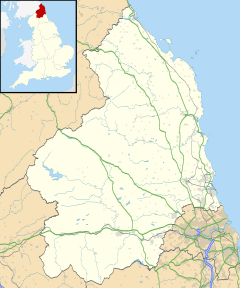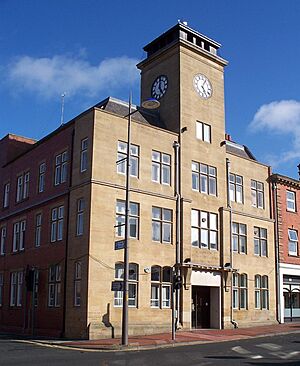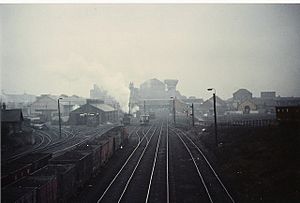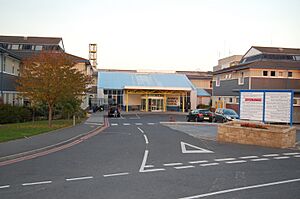Ashington facts for kids
Quick facts for kids Ashington |
|
|---|---|
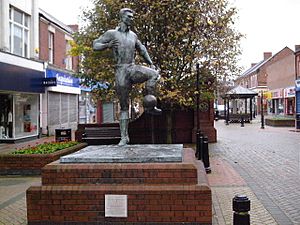 Jackie Milburn statue, Station Road, Ashington (October 2005) |
|
| Population | 27,764 (2011 census) |
| OS grid reference | NZ2787 |
| Civil parish |
|
| Unitary authority |
|
| Ceremonial county | |
| Region | |
| Country | England |
| Sovereign state | United Kingdom |
| Post town | ASHINGTON |
| Postcode district | NE63 |
| Dialling code | 01670 |
| Police | Northumbria |
| Fire | Northumberland |
| Ambulance | North East |
| EU Parliament | North East England |
| UK Parliament |
|
Ashington is a town in Northumberland, England. In 2011, about 27,864 people lived there. It was once a very important place for coal mining. The town is about 15 miles north of Newcastle upon Tyne. It sits west of the A189 road and has the River Wansbeck to its south. Many people in Ashington speak with a special accent and dialect called Pitmatic. This is different from the Geordie accent spoken in other parts of the region.
Contents
Discovering Ashington's Past
What's in a Name? Ashington's Origin
The name Ashington comes from an older name, Essendene. This name has been used since the year 1170. It might have come from a Saxon name, Æsc. If so, this person may have settled in the deep, wooded valley near Sheepwash. The name could also mean "ash tree valley," as these trees might have grown there. In the 1700s, Ashington was just a small farm with a few houses around it.
Ashington's Coal Mining Story
People first started mining in Ashington a very long time ago. Evidence of old bell-shaped pits and mine workings from monasteries have been found. Ashington began to grow from a small village in the 1840s. This happened when the Duke of Portland built homes to encourage people to work in his nearby coal mines. Many people came from Ireland, escaping the Great Famine.
Like in many parts of Britain, "deep pit" coal mining in Ashington slowed down in the 1980s and 1990s. The last coal mine, Ellington Colliery, closed in January 2005. For a long time, Ashington was known as the "world's largest coal-mining village." Today, people still discuss whether Ashington should be called a town or a village. If it's a village, it would be one of the biggest in England.
How Ashington Grew Over Time
As coal mining became bigger, more people moved from the countryside to Ashington. Because of this, the Ashington Coal Company built many rows of houses for miners. Some new people even came from Cornwall to use their tin-mining skills.
Ashington's railway station opened in 1878. Trains ran to Newbiggin and Tynemouth. By 1896, the town had grown so much that it became an Urban District. In 1913, the first Ashington Hospital was built. It was expanded with new parts in the 1950s and 60s.
Traditionally, the area east of the railway was called Hirst, and the west was Ashington. Both parts had their own parks: Hirst Park (opened in 1915) and the People's Park. The houses built by the coal company were in a grid pattern. Streets in Hirst were named after British trees, like Hawthorn Road. East-west streets were numbered avenues, from First Avenue to Seventh Avenue.
After the 1920s, the council built more houses, often semi-detached homes. New housing estates were built in different areas. A big building project in the late 1960s made Ashington grow southwards. Several new schools were built then, like Coulson Park. Later, in the 1980s and 90s, more estates like the Wansbeck Estate and Fallowfield Estate were built.
The End of Coal Mining
In 1964, Ashington railway station closed as part of the "Beeching Axe" plan. The station's site was later used for Wansbeck Square, which has a supermarket, council offices, and a library.
In 1981, the Woodhorn Pit closed. Its tall chimney was taken down. In the late 1980s, Woodhorn became a museum. Ashington Pit closed in 1988 and is now a business park.
The railway line was used until 2015 by the Alcan Aluminium plant to move coal. From 2017, the line was used again to transport materials for converting the power station to use biomass. In 2008, plans to dig up 2 million tonnes of coal in Ashington were approved. This project created over 60 jobs.
Ashington's Location and Surroundings
Ashington is in the southeast of Northumberland. This area is mostly flat and was formed when ancient forests became coal seams. The local rock is yellow sandstone. The land to the northwest of town is a bit bumpy because of mining subsidence, which sometimes causes floods. From some parts of town, you can see the Cheviot Hills about 30 miles away.
The town is roughly square-shaped, running north to south. The town centre is in the north. To the south are homes. Farmland is on both the east and west sides. The River Wansbeck borders the south. To the east is the coastal town of Newbiggin, and to the west is the small village of Bothal.
North of the town is Queen Elizabeth II Country Park. It has a lake surrounded by pine trees. The original Ashington Colliery was to the northwest, and the smaller Woodhorn Pit was to the northeast.
Weather and Soil
Ashington has a cool, mild climate. Summers are drier than on Britain's west coast, but cooler than southern areas. Winters are sometimes cold with snow. The soil is dark brown, drains well, and is good for growing vegetables.
| Climate data for Ashington, UK | |||||||||||||
|---|---|---|---|---|---|---|---|---|---|---|---|---|---|
| Month | Jan | Feb | Mar | Apr | May | Jun | Jul | Aug | Sep | Oct | Nov | Dec | Year |
| Mean daily maximum °C (°F) | 6 (43) |
7 (44) |
8 (47) |
10 (50) |
12 (54) |
16 (60) |
18 (64) |
18 (64) |
16 (61) |
13 (55) |
9 (48) |
7 (44) |
12 (53) |
| Mean daily minimum °C (°F) | 3 (37) |
3 (37) |
3 (38) |
5 (41) |
7 (45) |
10 (50) |
12 (54) |
12 (54) |
11 (52) |
8 (46) |
5 (41) |
3 (38) |
7 (44) |
| Average precipitation mm (inches) | 61 (2.4) |
43 (1.7) |
41 (1.6) |
43 (1.7) |
53 (2.1) |
46 (1.8) |
79 (3.1) |
79 (3.1) |
58 (2.3) |
64 (2.5) |
66 (2.6) |
58 (2.3) |
690 (27.2) |
| Source: Weatherbase | |||||||||||||
Getting Around Ashington
Train Travel
Ashington is served by the Northumberland Line. This line offers passenger train services from Ashington to Seaton Delaval and Newcastle. New stations are being built in Bedlington, Blyth, and Northumberland Park. Passenger services began on December 15, 2024.
Bus Services
At the east end of the main shopping street is the bus station. Local Arriva North East buses connect Ashington to the rest of Northumberland and to Newcastle. There are frequent services to places like Pegswood, Morpeth, Blyth, and Bedlington.
Roads
Ashington has good road connections. The A189 road, also known as the Spine Road, runs south to Newcastle. It connects to the A19 Tyne Tunnel, which leads to South Tyneside. The A1068 goes north along the coast to Alnwick. The A196 and A197 roads go west towards Morpeth and the A1. The A1 goes north to Scotland and Edinburgh, or south towards Durham and Yorkshire.
Air and Sea Travel
The closest airport is Newcastle Airport. It has flights to many cities in Europe and other parts of the world. There is also a port in nearby North Shields. From here, you can take a daily passenger ferry to IJmuiden in the Netherlands.
Places to Visit and Things to Do
Museums and Libraries
Ashington has a good-sized public library. It is located in the Leisure Centre on Lintonville Terrace. The local museum is at Woodhorn pit. It mainly shows the town's mining history with pictures and models. The museum also has art exhibits, including a permanent display of paintings by the Pitmen Painters. You can also find information about local history there.
Sports and Activities
Ashington has several sports facilities and many sports clubs. A new leisure centre opened in December 2015 on the site of the old Asda store.
Hirst Park has two bowling greens, as well as tennis and basketball courts. Ashington A.F.C. (the local football team) now plays at Woodhorn Lane. Rugby is played on a field at the northwest edge of town. Cricket is played near the town centre.
The former Miners Welfare centre on Alexandra Road has been turned into the Hirst Welfare Centre. This is a multi-use community place with training rooms, offices, a cafe, a hall, a gym, and a dance studio. It also has an outdoor, all-weather football pitch.
Parks, Walks, and Green Spaces
Riverside Park offers a peaceful place to relax or walk along the River Wansbeck. You can follow public paths from here towards the village of Bothal, which has a beautiful castle.
The People's Park, near the leisure centre, is a large green field perfect for recreation. Hirst Park is known for its summer flower displays. It has bowling greens, courts for basketball and tennis, and play areas. To the north of the park is a large sports field where fun fairs used to be held.
At Woodhorn is the Queen Elizabeth II Park. It is surrounded by pine woods, including the Ashington Community Woods. The park has a large lake and a narrow-gauge railway that connects the car park to the Woodhorn Museum. From here, you can walk towards Linton and east towards Newbiggin.
Ashington's location in Northumberland means it's easy to get to the countryside. The town is close to the coast, so you can quickly reach beaches like Druridge Bay and Cresswell. Northumberland National Park is also nearby.
Learning and Education
The way schools were set up in Ashington changed in September 2015. Before, there were first, middle, and high schools. Now, first schools are primary schools, and Ashington High School (now Ashington Academy) is a full secondary school. Many schools were first built by the Ashington coal company.
Northumberland College (formerly Ashington Technical College) is the main place for further education in town. It offers A levels, vocational courses, and evening classes.
Healthcare in Ashington
There are many doctors' offices (General Practitioner or GP surgeries) in Ashington. The main Wansbeck General Hospital is in the northeast of town, near Woodhorn. More serious treatments are done at hospitals in Newcastle. Emergency services are provided at the Northumbria Specialist Emergency Care Hospital in nearby Cramlington.
Local News and Media
Local newspapers include the Evening Chronicle and The Journal. These papers cover Tyneside and southeast Northumberland. The News Post Leader mostly covers the Wansbeck area.
Local radio stations are BBC Radio Newcastle (95.4 FM), Capital North East (105.3 FM), Heart North East (101.8 FM), Smooth North East (97.5 FM), Hits Radio North East (97.1 FM), and Koast Radio (106.6 FM), which is a community station based in Ashington.
Local news and TV shows come from BBC North East and Cumbria and ITV Tyne Tees. You can receive TV signals from the Pontop Pike or Chatton TV transmitters.
Jobs and Businesses
Until 1988, most men in Ashington worked in coal mining. When the mines closed, many people lost their jobs. However, some coal mining continued until recently at Ellington Colliery. Open-pit coal mining also happened at Butterwell Opencast.
The old Ashington Colliery site was redeveloped into Wansbeck Business Park. This park now has several companies, including Polar Krush NICC Ltd and Thermacore Ltd. The park also has a large pond and wildlife.
Because Ashington is close to Newcastle upon Tyne, it's a good town for people who work in the city to live.
Arts and Culture in Ashington
In 1934, some Ashington miners started taking painting classes for fun. They began to sell their paintings at local markets to earn extra money. They became surprisingly successful and were recognized by the art world. They had important art shows in the 1930s and 1940s, known as "The Pitmen Painters." The group themselves called it the "Ashington Group." In the 1970s, their work was "rediscovered" and became popular as "workers' art," leading to international exhibitions. On October 26, 2006, a new £16 million museum opened in Ashington to house their work.
The book The Pitmen Painters by William Feaver tells the story of the Ashington Group from 1934 to 1984. This book was turned into a stage play by Lee Hall, who is famous for Billy Elliot. The play first showed in Newcastle upon Tyne in 2007. It was later performed at the Royal National Theatre in London in 2008 and 2009.
Ashington has also appeared in various films and TV shows. These include Spender starring Jimmy Nail, Our Friends in the North in 1996, and The Fast Show on BBC2. The tall chimneys of the Alcan plant were even seen in the movie Billy Elliot.
Famous People from Ashington
- Ian Lavery, who was the President of the National Union of Mineworkers.
- William Timlin, an author and architect.
Sporting Heroes
Ashington has produced many professional footballers, including Jack Milburn, Jackie Milburn, Jimmy Adamson, Jack Charlton, and Bobby Charlton. Michael Oliver, the youngest referee in the Premier League's history, was born here. Sir John Hall, a former chairman of Newcastle United Football Club, was born nearby.
Cricketing brothers Steve Harmison and Ben Harmison are from Ashington, as are fellow cricketers Mark Wood and Simon Smith.
Golfer Kenneth Ferrie, who has played on the PGA Tour, is also from Ashington.
Images for kids
See also
 In Spanish: Ashington para niños
In Spanish: Ashington para niños


